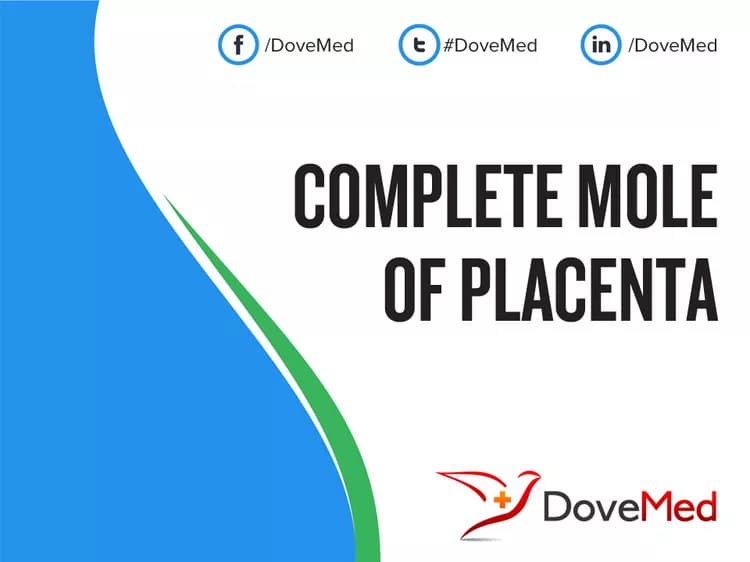What are the other Names for this Condition? (Also known as/Synonyms)
- CHM (Complete Hydatidiform Mole)
- Complete Hydatidiform Mole (CHM)
- Complete Molar Pregnancy
What is Complete Mole of Placenta? (Definition/Background Information)
- Complete Mole of Placenta is a growth or mass formation in the uterus occurring in the beginning of pregnancy. It occurs due to problems in fertilization, but the exact cause is currently not known. The condition is also known as Complete Molar Pregnancy
- Complete Mole of Placenta is an abnormally formed placenta and contains no fetal parts. The condition is typically observed in pregnant women who are greater than 30 years of age
- The common signs and symptoms associated with the condition are an enlarged uterus, severe nausea and vomiting, and vaginal bleeding. In rare cases, it may give rise to choriocarcinoma (cancer) of the uterus. Complete Mole of Placenta may be diagnosed through a blood test and ultrasound of the uterus
- In most of the cases, it is treated by dilatation and curettage (D&C) of the uterus. With appropriate treatment, the prognosis of Complete Mole of Placenta is good
The placenta is an organ that connects the developing fetus to the uterine wall.
- It is a disc shaped reddish brown structure that connects the fetus to the mother through the umbilical cord
- The umbilical cord contains two umbilical arteries and one umbilical vein, providing a connection between maternal and fetal blood circulation
- The normal function of placenta is to supply nutrients and oxygen to the fetus from the mother’s blood and remove wastes from the fetal body
- The chorion and amnion are placental membranes. The chorion is the membrane that is present between the growing fetus and the mother. The amnion closely covers and protects the developing embryo
Who gets Complete Mole of Placenta? (Age and Sex Distribution)
- A Complete Mole of Placenta (or a hydatidiform mole) can occur in pregnant women of all ages
- It is most common in women over 30 years of age
What are the Risk Factors for Complete Mole of Placenta? (Predisposing Factors)
Risk factors associated with Complete Mole of Placenta include:
- Age above 30 years
- Asians, Africans, or Latin Americans
- Vitamin A deficiency
- History of prior molar pregnancy
It is important to note that having a risk factor does not mean that one will get the condition. A risk factor increases ones chances of getting a condition compared to an individual without the risk factors. Some risk factors are more important than others.
Also, not having a risk factor does not mean that an individual will not get the condition. It is always important to discuss the effect of risk factors with your healthcare provider.
What are the Causes of Complete Mole of Placenta? (Etiology)
- Currently, the exact cause of Complete Mole of Placenta is unknown
- It is believed that certain problems during fertilization might cause the condition; however, the reason behind this remains unidentified
What are the Signs and Symptoms of Complete Mole of Placenta?
The signs and symptoms of Complete Mole of Placenta include:
- Large uterus than expected for dates (gestational period dates)
- Enlargement of ovaries
- Severe nausea and vomiting
- Vaginal bleeding
- Symptoms of hyperthyroidism such as heat intolerance, rapid heart rate, loose stools, restlessness, or nervousness
How is Complete Mole of Placenta Diagnosed?
The diagnosis of Complete Mole of Placenta may include:
- A thorough physical examination, correlated with a complete medical history (including family and social history)
- Blood test for the levels of beta-hCG
- Ultrasound of the uterus
- Uterine curettage and examination of tissue under a microscope: Cells and tissues are examined by a pathologist under a microscope. Pathological examination is generally considered to be a ‘gold standard’ for a definitive diagnosis. The pathologist arrives at a diagnosis after analyzing pathology findings along with clinical information of the patient. A pathologist may perform special studies on tissue samples to aid in the final diagnosis (if required)
Many clinical conditions may have similar signs and symptoms. Your healthcare provider may perform additional tests to rule out other clinical conditions to arrive at a definitive diagnosis.
What are the possible Complications of Complete Mole of Placenta?
Complications due to Complete Mole of Placenta could include:
- Pre-eclampsia: A pregnancy complication characterized by high blood pressure and signs of kidney damage in the mother
- Recurrence of the condition
- Rare chances of development of choriocarcinoma (a type of malignant cancer)
How is Complete Mole of Placenta Treated?
The treatment measures for Complete Mole of Placenta could include:
- Dilatation & curettage of the uterus: The uterine cervix is dilated and entire fetal tissue is removed
- Hysterectomy in case of severe bleeding and in women who do not wish to be pregnant (in future)
How can Complete Mole of Placenta be Prevented?
Currently, there are no definitive methods available to prevent Complete Mole of Placenta.
What is the Prognosis of Complete Mole of Placenta? (Outcomes/Resolutions)
- Overall, the prognosis of Complete Mole of Placenta is good with appropriate treatment
- Women require close follow-up for complete resolution of the condition
- Rarely choriocarcinoma can arise from a Complete Mole of Placenta
Additional and Relevant Useful Information for Complete Mole of Placenta:
The following DoveMed website link is a useful resource for additional information:
https://www.dovemed.com/diseases-conditions/pregnancy-related-disorders/
Related Articles
Test Your Knowledge
Asked by users
Related Centers
Related Specialties
Related Physicians
Related Procedures
Related Resources
Join DoveHubs
and connect with fellow professionals


0 Comments
Please log in to post a comment.